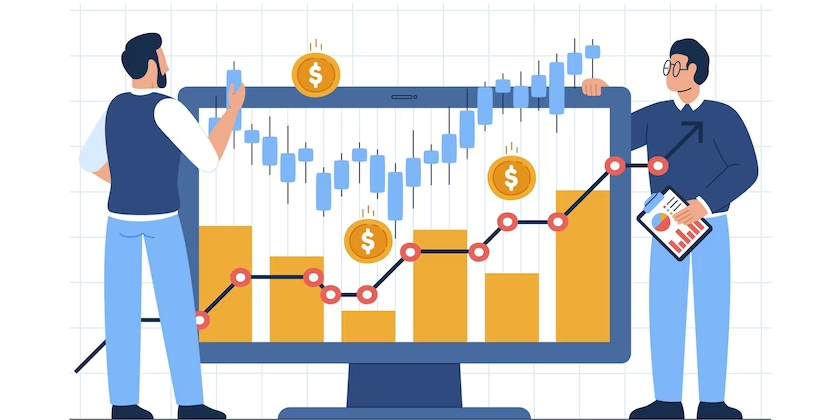Investors who want to participate in stock market activities have multiple approaches available. Although these approaches serve various objectives alongside distinct risk acceptance levels and contrasting investing durations. The three main ways in which traders approach stock market investing include day trading, swing trading and long-term investing. These three investing methods present specific advantages and particular challenges to overcome.
This article will take you through the differences between day trading vs. swing trading vs. long-term investing, explore their unique characteristics, and help you determine which strategy may work best for you.
What is Day Trading?
During a single trading session, traders execute buy and sell transactions for stocks, options and forex instruments. Market price fluctuations drive day traders to produce financial gain through numerous daily trading activities. Profits for traders stem from the rapid market shifts because they do not keep their assets overnight.
People who analyse day trades must conduct extensive research while leveraging and employing technical analysis tools for fast market decisions. Day trading tools and technical indicators help traders identify brief market opportunities that align with the timing of their precise day trading approach.
Begin your investing journey today. Your Demat account is the first step.
Day Trading Strategies
Day traders employ a variety of strategies to maximise their chances of success, including:
- Scalping: Scalpers generate profits through quick buying and selling at market fluctuations. Scalpers require substantial monetary resources to execute speedy trading operations, so they seek profits from minimal price differences and asset movements.
- Momentum Trading: Traders who practice Momentum Trading analyse stock movements for their momentum direction as they shift their positions when these movements become unstable.
- Breakout Trading: Major price movements should be expected by traders when they enter the market after prices reach support or resistance levels because the barrier has broken.
- News-Based Trading: During trading, traders modify their market positions based on price movements from official news disclosures and company earnings reports.
What is Swing Trading?
Swing trading is an investment method designed for durations from days to months. Swing traders allow their positions to remain open for extended terms ranging from several days to weeks or months to achieve price gains. Swing traders benefit when prices shift across short-term and medium-term intervals while using technical and fundamental evaluation to decide about secure buying and selling entries. Swing trading demands reduced trading intensity than day trading because traders benefit from bigger price movements through extended periods.
Swing traders operate independently from daily traders since they monitor their positions infrequently. Swing traders must monitor market indicators and news events that might influence their trading positions. Yet, they can operate away from their screens between trade sessions as day traders usually do.
The timeframe is a fundamental difference separating swing trading from investing because swing traders operate within shorter durations than investors maintain their investments. Swing traders usually maintain their investments for multiple days to months, but investors pursuing long-term strategies often keep their positions active for several years or decades.
Swing traders aim to achieve short-term revenue by analysing price movement behaviour. Investors concentrate on how their portfolio expands over extended periods by considering dividends and passive income from interest and other sources.
Swing Trading Risks
While swing trading involves less risk than day trading, it still carries notable swing trading risks, such as:
- Market Risk: Market movement during consecutive nights generates substantial price fluctuations, which lead to the financial detriment of the trader’s current trade position.
- Timing: Inappropriate timing of entries and exits leads traders to lose profitable chances and experience financial losses.
- Volatility: The extended time swing traders maintain their positions, which increases their vulnerability to market volatility. They do not have the advantage of short-term market fluctuations experienced by investors who operate on shorter timeframes.
What is Long-Term Investing?
Long-term investments focus on wealth accumulation when conducted for periods starting at a minimum of five years. Long-term investors base their strategy on achieving consistent long-term growth from their investments as they avoid short-term profit hunts. Buyers engaged in long-term investing should acquire assets with lasting fundamentals while keeping funds invested for multiple years to use profits through dividend payments and market valuation appreciation.
Long-term investing is usually less stressful than day trading or swing trading simply because they are not watching the market as closely for updates. Investors with a long-term investing strategy of ownership are usually focused more on the company’s underlying fundamentals, such as the potential of the earnings for the underlying company, its competitive position, or other significant trends in the underlying industry.
Long-Term Investment Risks
Though less risky in comparison to day trading or swing trading, long-term investing still involves risks, such as:
- Market Downturns: A long-term investor can face significant losses during prolonged bear markets.
- Company Risk: Individual stocks or assets may underperform, even over the long term, if the company experiences trouble.
- Inflation Risk: Over long periods, inflation can erode the purchasing power of your returns, especially if the investments do not keep pace with inflation.
Which Strategy is Right for You?
When choosing between day trading vs. swing trading vs. long-term investing, your decision should align with your financial goals, risk tolerance, and time commitment.
- Day trading is great for people who want to commit a lot of time to market research and technical analysis and can withstand a lot of risks.
- Swing trading provides a middle-ground between the fast pace of day trading and the longer patience of investing. It is best suited for those interested in mid-term price movements but do not want to commit to a term associated with holding for years.
- Long-term investing is best suited for people looking for a more passive approach and are willing to wait for their investments to compound over time while minimising costs and taxes.
Conclusion
Every one of these strategies—day trading, swing trading, or long-term investing—has pros and cons. What is appropriate is a function of your objectives as an investor, your risk capacity and tolerance, and how much maintenance you want to provide to your investments. If you are new to trading or want a more hands-off way to invest, perhaps check options directly through Religare Broking, which offers plenty of instruments and tools to help you select the best strategy. Visit Religare Broking and begin your journey to being a smarter investor today with professional assistance and tools that will help you create success!











